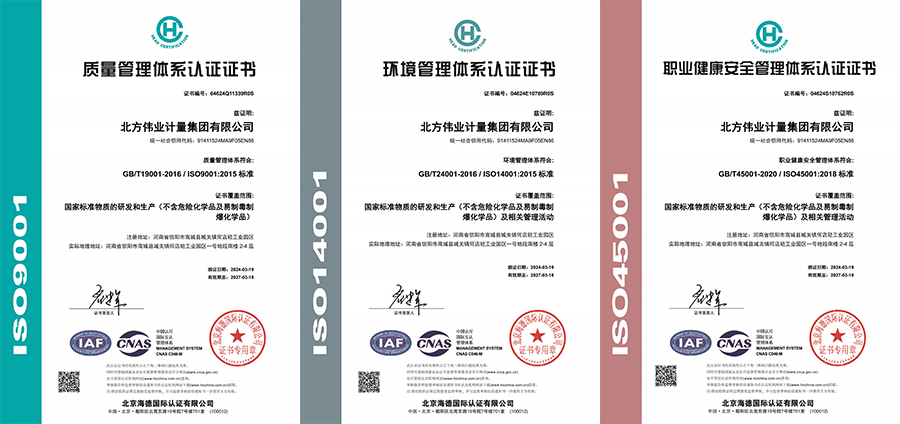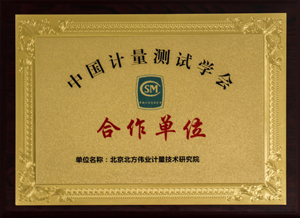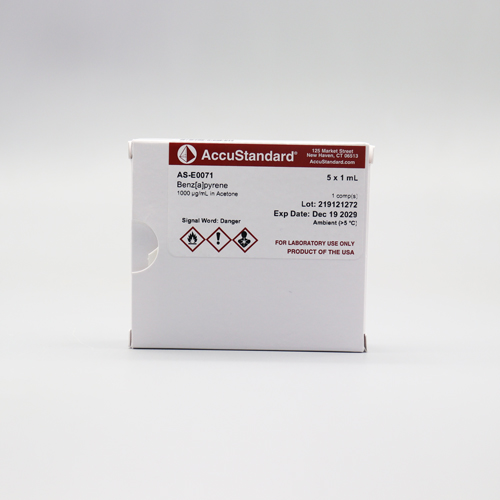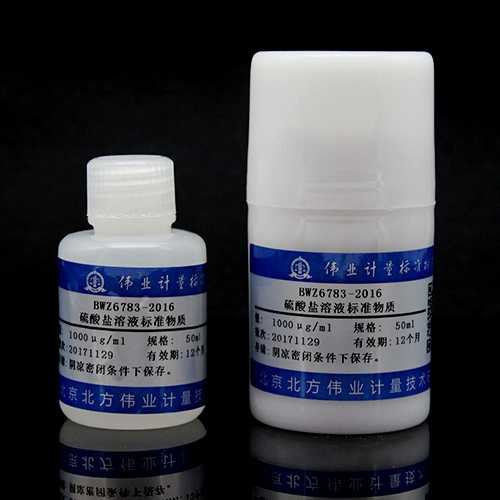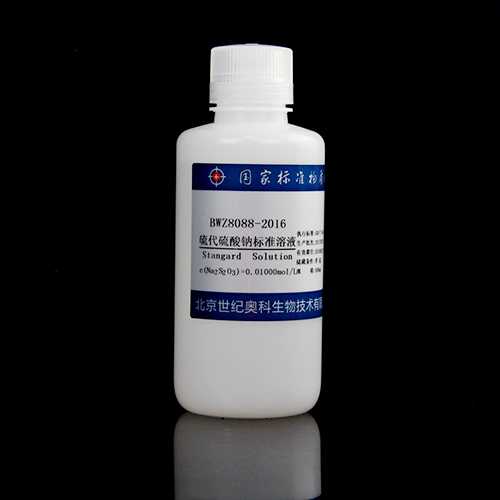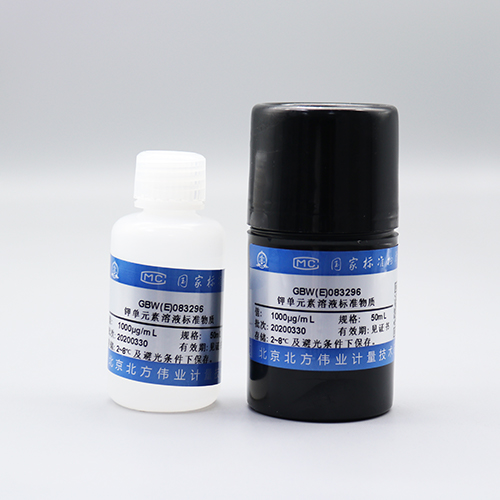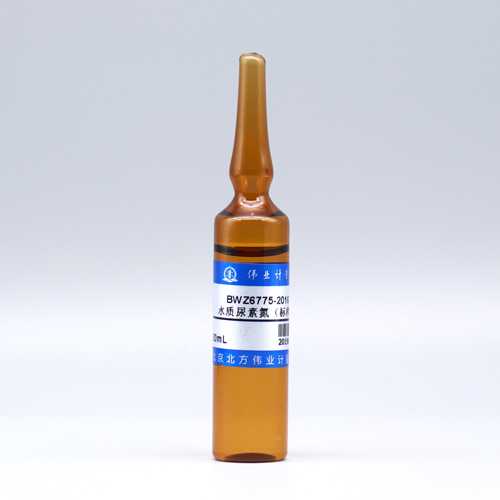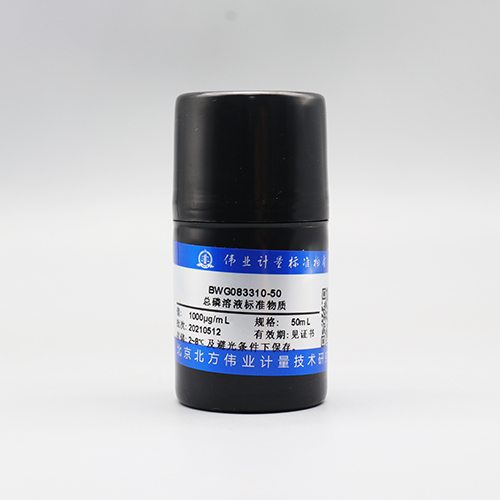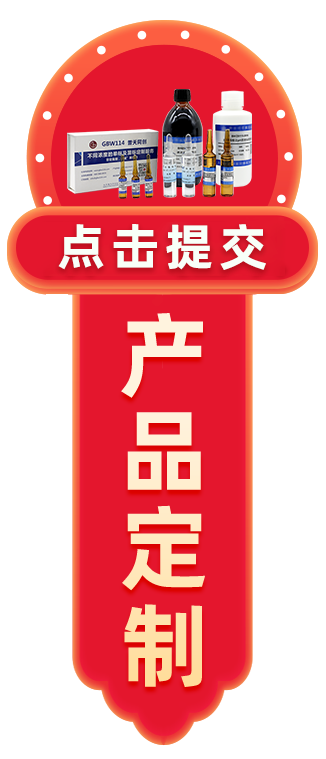Benz[a]pyrene
Solvent: Acetone
Hazards: Refer to SDS for complete safety information
Sample Size: 1 mL
Components: 1
Storage Condition: Ambient (>5 ℃)
| Component |
CAS # |
Purity % (GC/MS) |
Prepared Concentration2
(ug/mL)
|
Certified Analyte Concentration1
(ug/mL)
|
| Benz[a]pyrene |
50-32-8 |
100.0 |
1001 |
1001 |
1. Quality Standards:
IS0 17034 - General Requirements for the Competence of ReterenceMaterial Producers ANAB Certificate Number AR-1463
ISO/IEC 17025- General Requirements for the Competence of TestingAnd Calibration Laboratories ANAB Certificate Number AT-1339
ISO 9001:2015 - Quality Management System - RequirementsEagle Registrations Certificate Number 3774
2. Intended Use: The product covered by this certificate is designed for calibration or for use in quality control procedures
for the specified chemical compounds listed on the reverse side. This product can be used for quantification and/oridentification. This product can also be used as a reference material to validate analytical procedures, subject to theconditions under Section 7.
3. Manufacturing: All balances are calibrated daily using an in-house procedure with weights that are compared annually
to master weights and traceable to NIST.The balances are also calibrated annually by an ISO/IEC 17025 accreditedcalibration laboratory. Please refer to the NIST test number listed on the front of this certificate. Class A glasswareis used in the manufacture and quality control of all standards and calibrated using an in-house procedure. GoodLaboratory Practices have been used throughout the preparation of this Standard.
4. Homogeneity: This product is sufficiently homogeneous and any sample size would be within the uncertainty budget.
5. Stability: The manufacturer guarantees the stability of this solution through the expiration date stated on the label,
when handled and stored according to the conditions stated on the label
6. Uncertainty: The uncertainty values as stated on the face of this certificate have been determined using the
EURACHEM/CITAC Guide. We report a combined expanded uncertainty equal to the positive square root of the totalvariance of the uncertainty of the components using the following formula.This formula represents uncertainty components from the mass,volume, short-term stability,long-term stability and
homogeneity factors associated with the production of this product. The expanded uncertainty, assumes a normaldistribution and a coverage factor of k=2 is chosen using approximately a 95% confidence level.
7. Legal Notice and Limit of Liability: This product is for routine laboratory analysis and research purposes only. The
company's liability will be limited to replacement of product or refund of purchase price. Notice of claims must be madewithin thirty (30) days from date of delivery.
SECTION 2 - HAZARDS IDENTIFICATION - continued
2.1 - GHS Label Elements - continued
Precautionary Codes:
P202 - This product should only by used by persons trained in the safe handling of hazardous chemicals.P233 - Store in a tightly closed container.(P404)
P260 - Do not breathe vapor.
P262 - Do not get in eyes, on skin or clothing.
P264 - Wash thoroughly after handling. Do not take internally.Eye wash and safety equipment should be readilyavailable.
P280 - Protective gloves must be worn to prevent skin contact.
P284 - Respiratory Protection: If workplace exposure limit(s) of product or any component is exceeded (see
TLVIPEL), or a risk assessment shows air-purifying respirators are appropriate, use of a NIOSHMSHA approved airsupplied respirator is advised. Use a full-face respirator with multi-purpose combination (US) or type ABEK
(EN14387) respirator cartridges in absence of proper environmental control. Always use respirators and components tested and approved under appropriate government standards such as NIOSH (US) or CEN (EU)Engineering and/or administrative controls should be implemented to reduce exposure.
P331 - Ingestion:Do NOT induce vomiting.Call a physician or poison control center immediately. Never giveanything by mouth to an unconscious person.
P338 -Eye contact: lmmediately flush with plenty of water.After initial flushing, remove and contact lenses andcontinue flushing for at least 15 minutes. Assure adequate flushing by separating the eyelids with fingers.
P360 - Skin contact: lmmediately wash skin with soap and plenty of water.Remove contaminated clothing. Getmedical attention if symptoms occur. Wash clothing before reuse.
2.2 - Other Hazards
2.2.1-Symptom of Exposure Health/EnvironmentHighly Flammable(Flammable liquids, category 2)
Vapors may cause drowsiness and dizziness. (Specific target organ toxicity , single exposure; Narcotic effects,Category 3)
Causes skin redness and irritation.Repeated or prolonged exposure may cause dermatitis.2.2.2 - Potential Health Effects
Causes severe eye irritation.(Eye damagehirritation, category 2A)Irritating to skin. (Skin corrosionirritation,category 2)
May be harmful if absorbed through the skin. (Acute toxicity, dermal, category 5)
May be irritating to mucous membrane and upper respiratory system. (Specific target organ toxicity, singleexposure; Respiratory tract irritation. category 3)
May be harmful if inhaled.(Acute toxicity, inhalation, category 5)May be harmful if swallowed.(Acute toxicity, oral, category 5)2.2.3.- Routes of Entry
Inhalation. ingestion or skin contact.2.2.4 - Carcinogenicity
This product is or contains a component that is classified (ACGIH, IARC,NTP, OSHA) as a cancer hazard.(Carcinogenicity, category 1A)
California Proposition 65 Warning: This product contains a component (or components) that may cause cancer in aconcentration greater than or equal to 0.1%.
SECTION 3 - COMPOSITION/ ANALYTES DATA
Description: Benzo(a)pyrene in Acetone
| Analyte |
CAS# |
% Concentration |
| Benz[a]pyrene |
50-32-8 |
0.100 |
| Acetone |
67-64-1 |
99.900 |
SECTION 4 -FIRST AID MEASURES
4.1 - First Aid Procedures - General
Get medical assistance for all cases of overexposure.4.2-Eye Contact
Eye contact: /mmediately flush with plenty of water. After initial flushing, remove and contact lenses and continueflushing for at least 15 minutes. Assure adequate flushing by separating the eyelids with fingers. (P338)
4.3-Skin Contact
Skin contact: Immediately wash skin with soap and plenty of water.Remove contaminated clothing. Get medicalattention if symptoms occur.Wash clothing before reuse.(P360)
4.4 - Inhalation
Inhalation: Remove to fresh air. If not breathing, give artificial respiration or give oxygen by trained personnel. Seekimmediate medical attention.
4.5.-Ingestion
Ingestion: Do NOT induce vomiting. Call a physician or poison control center immediately. Never give anything bymouth to an unconscious person. (P331)
SECTION 5- FIRE FIGHTING MEASURES
5.1 - Flammable Properties
Dangerous fire and explosive hazard.
Vapors can travel to a source of ignition and flash back.Containers can build up pressure if exposed to heat.5.2- Extinguishing Media
Use alcohol foam, carbon dioxide, dry chemical, or water spray when fighting fires involving this material.5.3 -Protection of Firefighters
As in any fire, wear self-contained breathing apparatus pressure demand,MSHA/NIOSH (approved or equivalent)and full protective gear.
SECTION 6- ACCIDENTAL RELEASE MEASURES
6.1 -Spill Response
Wear suitable protective equipment listed under Exposure Controls / Personal Protection. Eliminate any ignitionsources until the area is determined to be free from explosion or fire hazards. Contain the release and eliminate itssource,if this can be done without risk. Dispose as hazardous waste. Comply with Federal, State and local
regulations.
SECTION 7-HANDLING AND STORAGE
Store in a tightly closed container.(P404)
SECTION7 - HANDLING AND STORAGE - continued
Store in a cool area away from ignition sources and oxidizers.Do not breathe vapor. (P260)
Use with adequate ventilation.
Do not get in eyes, on skin or clothing.(P262)Avoid prolonged or repeated exposure.
This product should only by used by persons trained in the safe handling of hazardous chemicals. (P202)
SECTION 8- EXPOSURE CONTROLS
8.1 - Engineering Controls/PPE
Wash thoroughly after handling. Do not take internally. Eye wash and safety equipment should be readily available.(P264)
8.2- General Hygene Considerations
Respiratory Protection: If workplace exposure limit(s) of product or any component is exceeded (see TLVIPEL), or arisk assessment shows air-purifying respirators are appropriate, use of a NIOSH/MSHA approved air supplied
respirator is advised. Use a full-face respirator with mult-purpose combination (US) or type ABEK (EN14387)respirator cartridges in absence of proper environmental control. Always use respirators and components testedand approved under appropriate government standards such as NlOSH(US) or CEN (EU). Engineering andoradministrative controls should be implemented to reduce exposure.
Material should be handled or transferred in an approved fume hood or with adequate ventilation.Protective gloves must be worn to prevent skin contact. (P280)
(Butyl, chloroprene, natural rubber or equivalent)
Use eye protection tested and approved under the appropriate govemment standards such as NIOSH (US)or EN166(EU).
All recommendations are advisory only and must be evaluated by an industrial hygienist and/or safety officer familiarwith the specific situation of anticipated use, such as concentration and amount of the substance in the workplace.Any recommendation should not be construed as offering an approval for any specific use of the product.
SECTION 9 - PHYSICAL AND CHEMICAL PROPERTIES
Appearance: Clear liquid
Odor: Pungent odor
Odor Threshold: N/A
pH: N/A
Melting Point:-94.8°C
Boiling Point:56.2°C
Flash Point: 1 RF(-17°C) (cc)
Evaporation Rate(Butyl Acetate=1): 7.7
Flammability Class: IB
Lower Flammability Level: 2
Upper Flammability Level: 13
Vapor Pressure:184 mmHg (20 °C)
Vapor Density (Air = 1): 2.0
Specific Gravity: 0.789 g/cm3
Solubility in Water: Miscible
SECTION 9- PHYSICAL AND CHEMICAL PROPERTIES - continued
Partition Coefficient: log Pow: -0.24
Autoignition Temperature: 465°C
Decomposition Temperature: N/A
Viscosity: N/A
voC Content: NA
Percent Volatile: 99+
SECTION10-STABILITY AND REACTIVITY
Stability: Stable
Materials to Avoid: Oxidizers
Bases
Hazardous Decomposition: Oxides of carbon
Hazardous Polymerization: Will not occur
Condition to Avoid: Heat; Contact with ignition sources
SECTION 11.-TOXICOLOGICAL INFORMATION
Human Health Toxicity
See section 2 for specific toxicological information for the ingredients of this product.
LD50(Oral): Rat - 5800 mg/kg
LD50 (Dermal): Guinea Pig - >2000 mg/kg
LC50 (Inhalation): Rat - >20 mg/L
WARNING: This product contains chemical(s) known to the state of California to cause cancer.No other information related to the toxicological properties of this product is available at this time.
注:证书信息仅供参考,以产品附带证书为准。




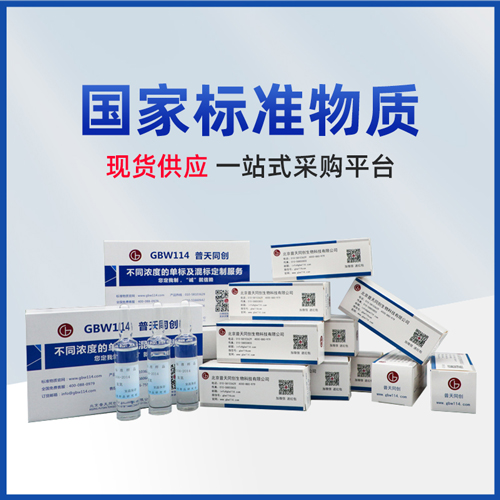 (玉米油)食用油中苯并芘质控样品
编号:PKL02011703585C 规格:30mL
(玉米油)食用油中苯并芘质控样品
编号:PKL02011703585C 规格:30mL
 苯并α芘检测标准品
编号:B-746508 CAS号:50-32-8 规格:10mg 浓度:97.1%
苯并α芘检测标准品
编号:B-746508 CAS号:50-32-8 规格:10mg 浓度:97.1%
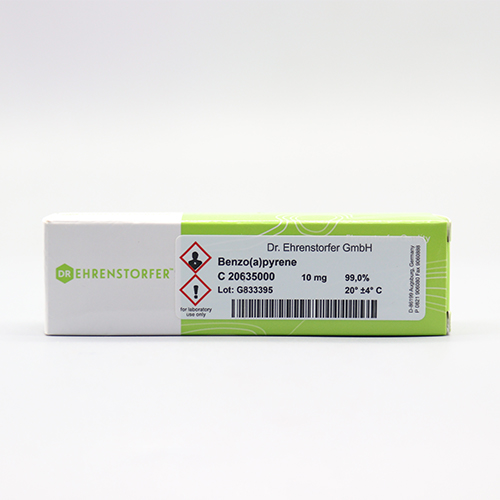 苯并()芘
编号:CDCT-C20635000 CAS号:50-32-8 规格:10mg 浓度:纯品型,有证书
苯并()芘
编号:CDCT-C20635000 CAS号:50-32-8 规格:10mg 浓度:纯品型,有证书
 苯并芘分子印迹固相亲和柱
编号:MIP-110-6-25 规格:500mg/6mL
苯并芘分子印迹固相亲和柱
编号:MIP-110-6-25 规格:500mg/6mL
 (玉米油)食用油中苯并芘质控样品
编号:PKL02011703585F 规格:30mL
(玉米油)食用油中苯并芘质控样品
编号:PKL02011703585F 规格:30mL
 食用油(苯并芘)理化类
编号:QC-CO-702 规格:20g
食用油(苯并芘)理化类
编号:QC-CO-702 规格:20g


